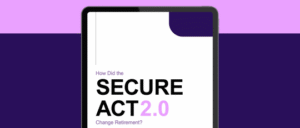
Read Time: 3 min
As retirement planning continues to evolve, so do the rules governing 401(k) plans and catch-up contributions. A provision of the SECURE Act 2.0 states that high-income earners would no longer be allowed to make catch-up contributions to their 401k on a tax-deferred basis. It has been nearly three years since the bill passed, and the IRS has recently provided clarity on when and how these new rules are being implemented. Starting in 2026, significant changes are set to impact how certain employees can make catch-up contributions to their 401(k) retirement accounts.
What are Catch-up Contributions
Catch-up contributions are additional amounts that individuals aged 50 and older can contribute to their 401(k) plans, above the standard annual contribution limit. These contributions are designed to help older workers boost their retirement savings as they approach retirement age. For the 2025 tax year, employees aged 50 and older can make catch-up contributions up to $7,500 in addition to the regular 401(k) contribution limit. These catch-up contributions can be made on a pre-tax (traditional) or post-tax (Roth) basis, depending on their employer plan options and the employee’s preference.
Key Changes Coming in 2026
Beginning in 2026, new legislation will alter how catch-up contributions work for higher-income employees. The most significant shift centers on the tax treatment of these contributions for high earning individuals. Employees aged 50 and older whose wages from the previous calendar year exceed $145,000 (indexed for inflation) will be required to make catch-up contributions on a Roth (after-tax) basis. This means these contributions will be taxed up front but can grow and be withdrawn tax-free in retirement. Employees below this income level can continue making catch-up contributions as before.
“High Earner” Considerations
-
- Tax Planning: High earners should assess how mandatory Roth catch-up contributions will affect their take-home pay and overall tax situation. Planning ahead can help mitigate any unexpected tax liabilities.
- Retirement Strategy: Since Roth 401(k) contributions grow tax-free, some employees may benefit from diversifying their retirement savings between traditional and Roth accounts.
- Check Plan Features: Employees should confirm whether their employer’s 401(k) plan offers a Roth option and, if not, inquire about upcoming changes to comply with the new regulations.
The 2026 changes to 401(k) catch-up contributions mark a significant shift for high-income earners and employers alike. Understanding these new rules and preparing well in advance can help ensure compliance and maximize retirement savings opportunities. Both employees and employers should review their plans, consult with financial advisors, and take proactive steps to adapt to the evolving retirement landscape.
This content is developed from sources believed to be providing accurate information. The information in this material is not intended as tax or legal advice. It may not be used for the purpose of avoiding any federal tax penalties. Please consult legal or tax professionals for specific information regarding your individual situation. The opinions expressed and material provided are for general information and should not be considered a solicitation for the purchase or sale of any security.

Recent Comments